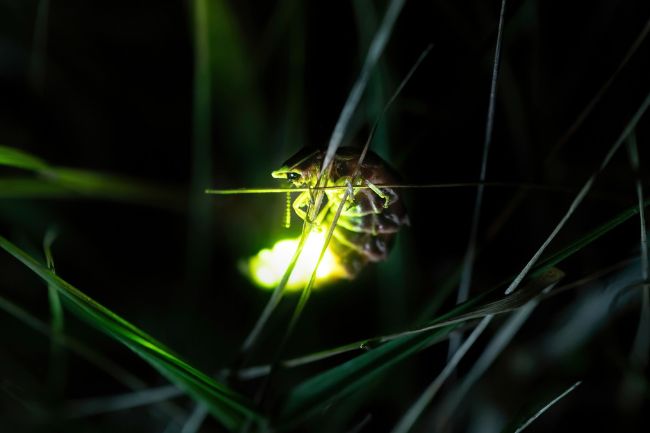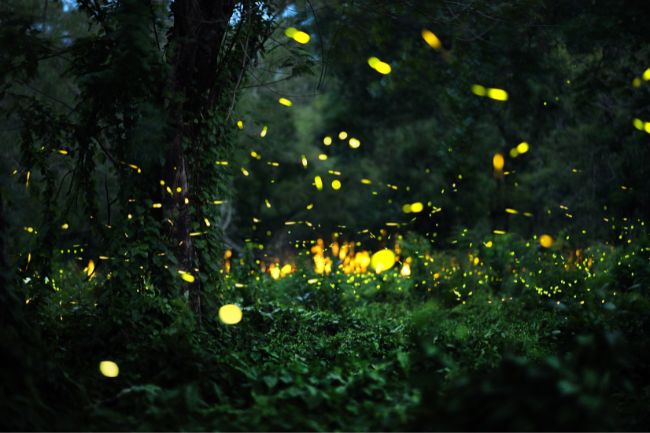Fireflies need a variety of things to be able to survive and glow, including oxygen and food. However, not all species glow, and within certain species, adults may not glow, so it is also depends on the individual firefly.
Contents
What are fireflies?

Fireflies are well known across much of the world for the magical glow that they can emit, often in large groups, creating a fascinating nighttime display. Across the world, there are over 2,000 species of firefly, found across most of the world’s tropical and temperate regions, from North America to India, to Japan.
Fireflies are a type of beetle and include the three species of glowworms found in the UK. The glowworms of New Zealand, however, are a different species altogether, being the larval form of a fungus gnat.
The light of the firefly comes from a form of bioluminescence, that requires a chemical reaction to occur within the firefly’s lantern. The lantern is the last few segments of the firefly’s abdomen.
A firefly’s lifecycle, like the lifecycle of many beetles, starts as an egg. The egg is laid by the female, often on the surface of the soil, or underground. Once it hatches, the firefly larvae spend their time hunting and eating, usually feeding on snails and other soft-bodied invertebrates.
Throughout the larva’s life, it will continuously shed its exoskeleton, in order to grow. The exoskeleton is a hard external skin that prevents the animal from being able to get any bigger. Shedding allows the larvae to emerge from their old skin with a new, soft skin ready to allow it to grow.
| Firefly Species | Preferred Habitat |
|---|---|
| Photinus pyralis | Forests, meadows, and gardens |
| Photuris lucicrescens | Wetlands and marshes |
| Lampyris noctiluca | Woodlands and grassy areas |
| Pyractomena angulata | Deciduous forests and wetlands |
Most larvae will overwinter, usually spending this time in diapause, a type of hibernation. When the time comes for them to transform into adults, the larvae will become a pupa. This is what is known as metamorphosis, and is the same process a caterpillar goes through to become a butterfly.
The final stage of the firefly’s life is that of its adult form. Male adult fireflies usually look like beetles, while the females will often retain a form similar to the larva, and not be able to fly. In some species, both the larvae and the adults will glow, while in others it may just be the adults. Some species do not glow at all.
Most fireflies like to live near water, though they can be found in habitats ranging from woodlands to the edge of ponds, to meadows.
Also read: What Caterpillars turn into Monarch Butterflies? (A List)
Can you keep fireflies as pets?
Fireflies aren’t usually sold as pets, as most people find them difficult to keep alive in captivity. This may be because their requirements are not fully understood.
| Firefly Species | Breeding Season | Mating Behavior |
|---|---|---|
| Photinus pyralis | Late spring to early summer | Males flash patterns to attract females for mating |
| Photuris lucicrescens | Late summer to early fall | Females mimic the flash patterns of other fireflies to attract and consume males |
| Lampyris noctiluca | Summer | Males fly and flash to attract females for mating |
| Pyractomena angulata | Late spring to early summer | Males fly and emit pheromones to attract females for mating |
Rather than keeping them for their whole lifecycle, a common pastime has been to collect and look after fireflies for short periods of time, to study and enjoy them at close quarters. However, it is generally advised not to keep them in captivity for more than a few days, as they must be allowed to continue with their lifecycle.
How to keep your firefly alive and glowing

Firstly, it’s important to ensure you have a firefly that does glow. Not all fireflies glow, and within species, different stages or sexes may not glow either. Understanding what species you have and which members of this species glow, can be very useful.
Also read: Firefly Larvae: Do They Glow, How do They Live & More
Oxygen
Fireflies use a chemical reaction to create their bioluminescence. One of the most important parts of this reaction is the presence of oxygen. Not only is oxygen important to help create the glow the fireflies are famous for, but it is also important to help them to breathe.
Therefore, whatever container you have your fireflies in must allow enough oxygen to enter. This might be through openings or holes, but they must be able to breathe and access oxygen in order to glow.
Food
Whether your fireflies will require food will again depend on the stage and species. While all larvae will need to feed, some adults do not feed at all. The food fireflies eat can also depend on the stage they are at.
Larvae are generally thought to eat a range of soft-bodies invertebrates, such as snails and worms. Adults on the other hand are thought to eat mostly nectar and pollen. Some adult fireflies are cannibalistic, eating other fireflies.
| Firefly Species | Preferred Food Sources |
|---|---|
| Photinus pyralis | Nectar, pollen, and small insects |
| Photuris lucicrescens | Other fireflies and soft-bodied insects |
| Lampyris noctiluca | Snails, slugs, and small invertebrates |
| Pyractomena angulata | Snails, worms, and insect larvae |
Without enough energy, it’s unlikely your fireflies will want to glow, meaning that giving them the correct food is important. What you offer them will depend on the species and age of the animal. If you want to avoid having to cater for your guest, you can simply opt to keep them for a short period of time, less than an hour, before releasing them back to where they can find food.
Timing
When it comes to nature, there are often many things that we as humans cannot control. Most fireflies only glow at certain times of the year, and at certain times of the day. Many will only light up during the dead of night, not even choosing to glow for very long.
Adult fireflies also use their glow to attract a mate, meaning that their display is only started during the mating season. It is, therefore, useful to know what species you have, and when they might be willing to light up the night, or you may find yourself disappointed waiting for a display.
Keeping wildlife wild
While the beauty of nature often leads us as humans to want to possess and own it, it’s important to remember that most wild creatures are happiest, and best catered for, out in their wild habitats.
While placing fireflies in a jar for a little time to admire them isn’t particularly harmful in the short term, keeping them for longer periods could result in their deaths without mating, which then reduces the number of fireflies the following year.
The best way, therefore, to enjoy fireflies’ glow, is to head out into their world, and watch them do what they do best. After all, one or two fireflies in a jar might be pretty, but hundreds of them flashing together in the wild is spectacular.

